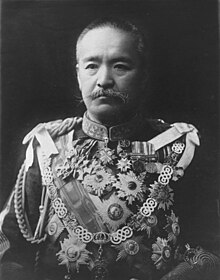Taro Katsura
| Katsura Tarō | |
|---|---|
| 桂 太郎 | |
 |
|
| 6th Prime Minister of Japan | |
|
In office December 21, 1912 – February 20, 1913 |
|
| Monarch | Taishō |
| Preceded by | Saionji Kinmochi |
| Succeeded by | Yamamoto Gonnohyōe |
|
In office July 14, 1908 – August 30, 1911 |
|
| Monarch | Meiji |
| Preceded by | Saionji Kinmochi |
| Succeeded by | Saionji Kinmochi |
|
In office June 2, 1901 – January 7, 1906 |
|
| Monarch | Meiji |
| Preceded by | Saionji Kinmochi (Acting) |
| Succeeded by | Saionji Kinmochi |
| Governor General of Taiwan | |
|
In office June 2, 1896 – October 14, 1896 |
|
| Monarch | Meiji |
| Preceded by | Kabayama Sukenori |
| Succeeded by | Nogi Maresuke |
| Personal details | |
| Born |
January 4, 1848 Hagi, Chōshū Domain, Japan |
| Died | October 10, 1913 (aged 65) Tokyo, Japan |
| Political party | Constitutional Association of Allies (1913) |
| Other political affiliations |
Independent (1896–1913) |
| Profession | General |
| Signature |  |
Prince Katsura Tarō (桂 太郎?, January 4, 1848 – October 10, 1913) was a general in the Imperial Japanese Army, politician and the longest serving Prime Minister of Japan, having served three terms.
Katsura was born into a samurai family from Hagi, Chōshū Domain (present day Yamaguchi Prefecture). As a youth, he joined the movement against the Tokugawa shogunate and participated in some of the major battles of the Boshin War that led to the Meiji Restoration.
The new Meiji government considered that Katsura displayed great talent, and sent him to Germany to study military science. He served as military attaché at the Japanese embassy in Germany from 1875–1878 and again from 1884-1885. On his return to Japan, he was promoted to major general. He served in several key positions within the Imperial Japanese Army, and in 1886 was appointed Vice-Minister of War.
During the First Sino-Japanese War (1894–1895) Katsura commanded the IJA 3rd Division under his mentor, Field Marshal Yamagata Aritomo. During the war, his division made a memorable march in the depth of winter from the north-east shore of the Yellow Sea to Haicheng, finally occupying Niuchwang, and effecting a junction with the IJA 2nd Army which had moved up the Liaodong Peninsula.
...
Wikipedia
